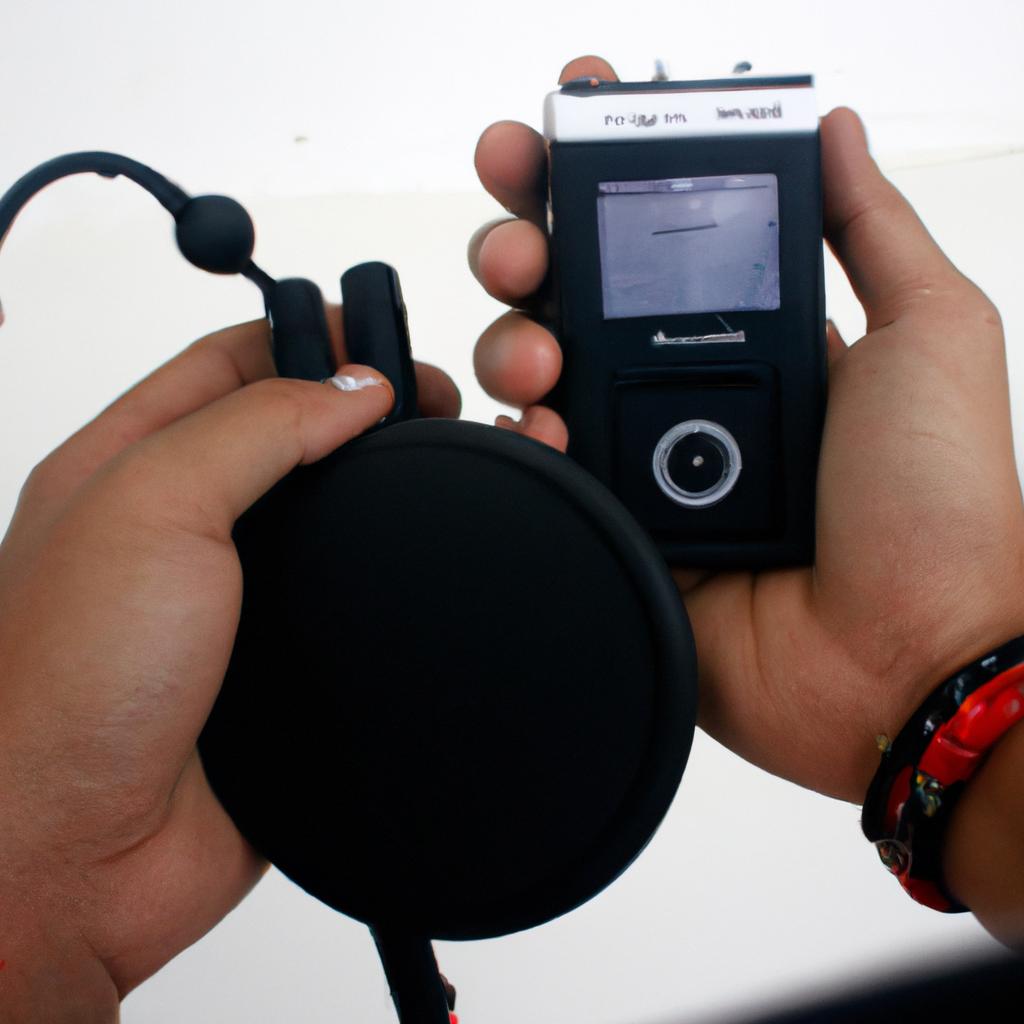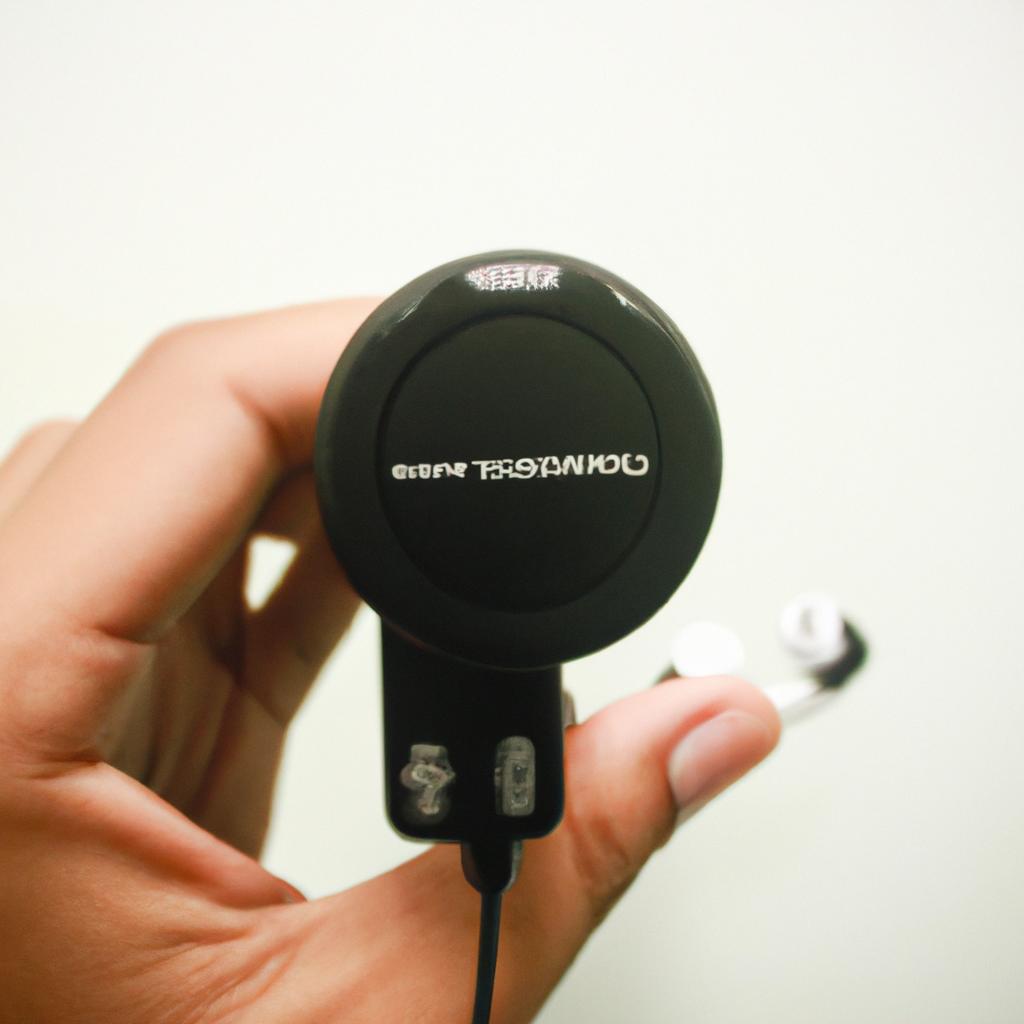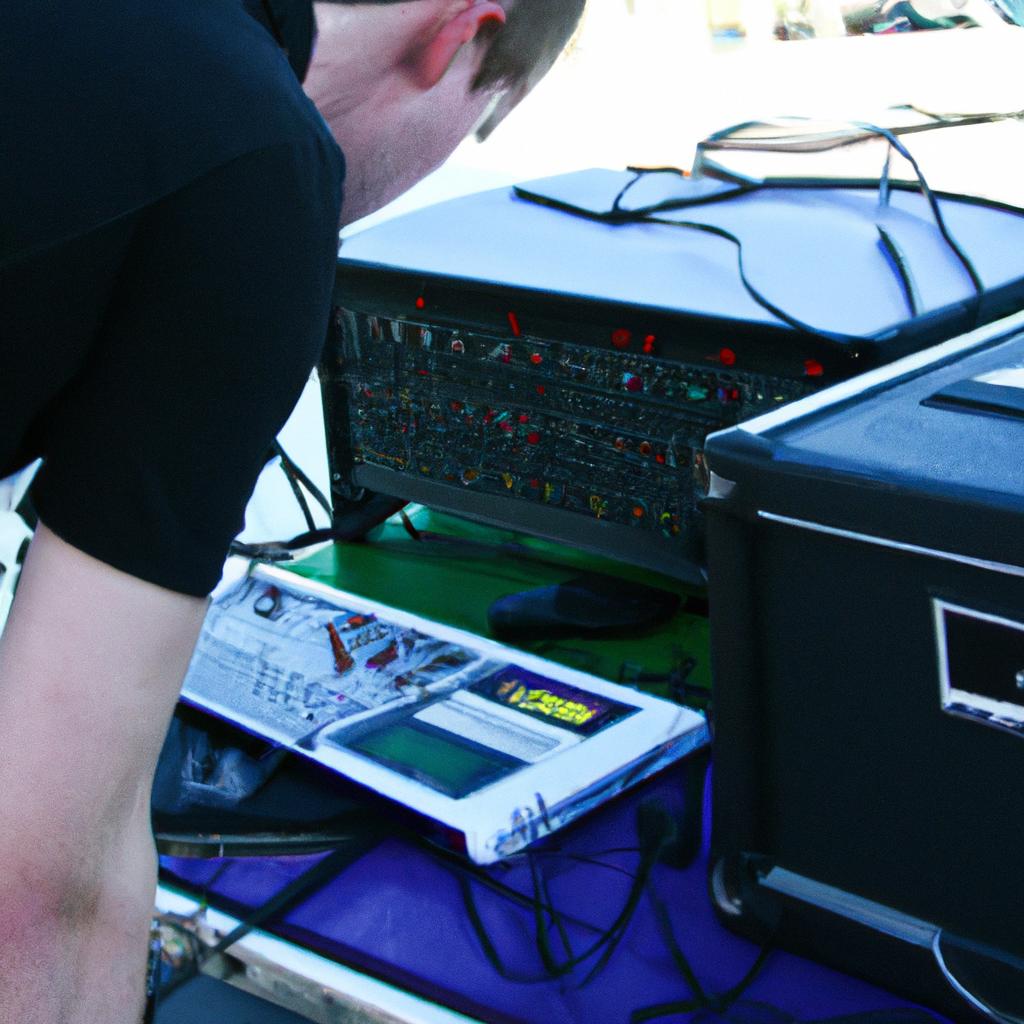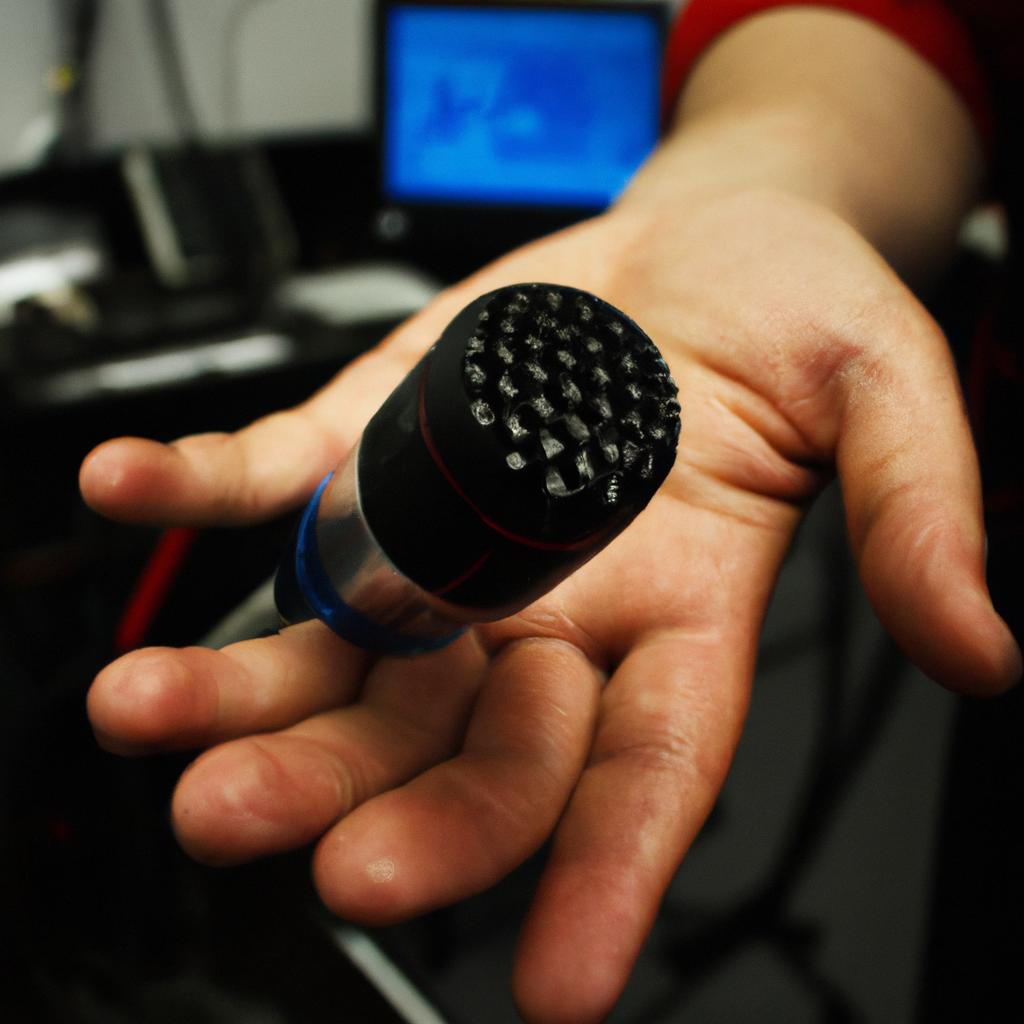The advent of wireless connectivity has revolutionized the field of audio equipment, enabling seamless transmission and reception of sound signals without the need for physical connections. This technology has not only eliminated cumbersome wires but also opened up new possibilities in terms of convenience and flexibility. For instance, imagine a scenario where a professional musician wants to record music in a spacious studio while simultaneously controlling multiple audio devices from different locations. With wireless connectivity, this becomes achievable as it allows for real-time communication between various components of an audio setup.
In recent years, there has been significant advancement in wireless connectivity technologies specifically designed for sound and vision applications. These innovations have led to the development of sophisticated systems that can transmit high-quality audio signals over long distances without compromising on performance. Wireless microphones, for example, provide freedom of movement for performers on stage, allowing them to deliver captivating performances without being restricted by cables or cords. Moreover, wireless speakers have gained popularity due to their ability to seamlessly integrate into any living space while delivering exceptional sound quality.
This article aims to explore the various aspects related to wireless connectivity in sound and vision with a specific focus on audio equipment. By examining the underlying principles and technical advancements in this domain, we will delve into its potential benefits as well as challenges faced by professionals in the audio industry.
One of the main benefits of wireless connectivity in audio equipment is the freedom it provides to professionals. With wireless technology, musicians, sound engineers, and other audio professionals can move around freely without being tied down by cables. This opens up new possibilities for live performances and studio recordings, as artists can explore different spatial arrangements and experiment with their creativity.
Additionally, wireless connectivity allows for easier setup and installation. Without the need for physical connections, setting up a wireless audio system becomes much simpler and less time-consuming. This can be particularly beneficial in scenarios where multiple devices need to be interconnected or when there are space constraints.
Moreover, wireless connectivity enables seamless integration with other smart devices and systems. Many modern audio equipment now come equipped with Bluetooth or Wi-Fi capabilities, allowing them to connect wirelessly to smartphones, tablets, computers, and even home automation systems. This integration offers enhanced control options and greater flexibility in managing audio setups.
However, despite its advantages, wireless connectivity in audio equipment also presents some challenges. One common issue is interference from other wireless devices operating in the same frequency range. This can result in signal loss or degradation if not properly managed. Manufacturers have been addressing this concern through advanced frequency-hopping techniques and improved signal processing algorithms.
Another challenge is latency or delay in transmitting audio signals wirelessly. In certain applications where real-time monitoring or synchronization is crucial, such as live performances or video production, minimizing latency becomes essential. Technological advancements have been made to reduce latency levels significantly but achieving zero-latency transmission remains a complex task.
Furthermore, maintaining stable and reliable connections over long distances can be challenging due to factors like obstructions and signal attenuation. Professionals working in large venues or outdoor settings often face these hurdles when implementing wireless audio solutions. Antenna placement optimization and using higher power transmitters can help mitigate these problems to some extent.
Overall, the advent of wireless connectivity has brought about significant advancements in the field of audio equipment. It has provided professionals with greater freedom, flexibility, and convenience in their work. However, it is important to carefully consider the specific requirements of each application and address potential challenges to ensure optimal performance and reliability when utilizing wireless technology in sound and vision systems.
Wireless Connectivity: A Game-Changer in Audio
The advent of wireless connectivity has revolutionized the audio industry, providing users with unprecedented convenience and flexibility. Gone are the days when tangled cords restricted movement and limited accessibility to audio devices. With the introduction of wireless technology, individuals can now enjoy seamless connections between their sound systems and various devices such as smartphones, tablets, or computers.
To illustrate the impact of wireless connectivity, let us consider a hypothetical scenario. Imagine an individual hosting a gathering at their home, wanting to create an immersive musical experience for their guests. In the past, setting up speakers required tedious cable management and constrained placement options. However, thanks to modern advancements in wireless technology, this person can effortlessly connect multiple speakers throughout their living space without any physical limitations. This not only enhances the overall audio quality but also allows for easy control over volume levels and equalizer settings via a centralized device.
Wireless connectivity brings about numerous benefits that significantly enhance user experiences:
- Convenience: Users no longer need to worry about tripping over cables or restricting themselves within close proximity to their audio equipment.
- Flexibility: Wireless connections offer greater freedom in speaker placement, allowing users to optimize sound distribution according to room acoustics.
- Portability: The ability to wirelessly connect portable devices like smartphones or tablets enables music playback from virtually anywhere within range.
- Seamlessness: With advanced pairing technologies such as Bluetooth or Wi-Fi Direct, establishing connections between devices has become effortless and hassle-free.
Furthermore, these advantages can be better understood through a comparative analysis:
| Aspect | Wired Connection | Wireless Connection |
|---|---|---|
| Convenience | Requires cable setup | No cable restrictions |
| Flexibility | Limited placement options | Freedom in positioning speakers |
| Portability | Fixed connection point | Portable device compatibility |
| Seamlessness | Manual configuration | Automatic and quick pairing |
In summary, wireless connectivity has emerged as a game-changer in the audio industry. Its ability to eliminate physical constraints, offer flexibility, enhance portability, and provide seamless connections between devices has revolutionized the way individuals interact with their audio equipment. In the subsequent section, we will explore the evolution of wireless technology in audio, further delving into its remarkable advancements over time.
*[Wi-Fi]: Wireless Fidelity
The Evolution of Wireless Technology in Audio
The use of wireless technology has revolutionized the field of audio equipment, bringing with it a host of benefits and opportunities. This advancement has transformed how we experience sound and vision, opening up new possibilities for both professional and consumer applications.
Consider the case of a live music performance where multiple speakers are strategically placed throughout a venue to create an immersive listening experience. In a traditional setup, connecting each speaker with wires would be laborious and time-consuming. However, with wireless connectivity, these speakers can be effortlessly linked together, allowing for easy control and adjustment from a central location. This not only saves time but also improves flexibility and convenience during setup and dismantling.
Moreover, wireless connectivity offers numerous advantages that continue to push the boundaries of audio technology:
- Enhanced mobility: Wireless audio equipment allows performers or presenters to move freely around the stage or room without being restricted by cables.
- Increased accessibility: With wireless systems, individuals with hearing impairments can utilize assistive listening devices more conveniently.
- Simplified integration: Wireless connectivity facilitates seamless integration between various audio devices such as microphones, amplifiers, mixers, and speakers.
- Expanded range: Wireless signals can cover larger distances compared to wired connections, enabling audio distribution over extended areas.
To illustrate these benefits further, let us consider a hypothetical scenario involving different types of audio equipment commonly used in professional settings:
| Device | Wired Connection | Wireless Connection |
|---|---|---|
| Microphone | Requires XLR cable connection to mixer | Connects wirelessly using Bluetooth or Wi-Fi |
| Speaker | Connected via long speaker cable | Wirelessly pairs with source device such as smartphone or computer |
| Headphones | Plugs into headphone jack on playback device | Connects wirelessly via Bluetooth or NFC technology |
As we can see from this table, wireless connectivity eliminates the need for physical cables in connecting audio devices. This not only simplifies the setup process but also reduces the risk of tripping hazards and cable tangling.
In summary, wireless connectivity has revolutionized the audio equipment industry by providing a more efficient, flexible, and convenient way to transmit sound signals. The benefits it offers extend beyond convenience alone, encompassing enhanced mobility, increased accessibility for individuals with hearing impairments, simplified integration between devices, and expanded range of coverage. In the next section discussing “Benefits of Wireless Connectivity in Audio Systems,” we will delve deeper into how these advantages translate into real-world applications and user satisfaction.
Benefits of Wireless Connectivity in Audio Systems
Section: The Impact of Wireless Connectivity on Sound Quality
In recent years, the advent of wireless technology has revolutionized audio equipment, enhancing sound quality and offering increased convenience. To illustrate this impact, let’s consider a hypothetical scenario where a music enthusiast is looking to upgrade their home audio system. With an array of wireless options available in today’s market, they are faced with a multitude of choices that can significantly enhance their listening experience.
One key benefit of wireless connectivity in audio systems lies in its ability to eliminate cumbersome cables and wires. Gone are the days when listeners had to navigate through tangled cords or limit themselves to specific locations due to cable constraints. By embracing wireless technology, users gain the freedom to position speakers wherever they desire without compromising on sound quality. This newfound flexibility ensures an optimal acoustic experience throughout any living space.
Moreover, wireless connections enable seamless integration across multiple devices and platforms. Imagine effortlessly streaming your favorite playlist from your smartphone while simultaneously connecting it with other compatible devices such as smart TVs or laptops for synchronized playback. Such versatility eliminates the need for physical media storage and allows for easy access to a vast library of digital content at our fingertips.
To further emphasize the significance of wireless connectivity in audio systems, consider the following bullet points:
- Enhanced mobility: Users can move freely within their environment without being tethered to a fixed audio source.
- Effortless setup: Setting up wireless audio equipment requires minimal technical expertise and reduces installation time compared to traditional wired systems.
- Expanded range: Wireless signals can transmit over longer distances than standard cables, accommodating larger spaces and outdoor areas.
- Seamless multi-room capabilities: With wireless connectivity, different rooms can be connected seamlessly, allowing synchronized playback throughout the entire household.
Below is a table highlighting some key advantages offered by wireless connectivity:
| Advantages | Description |
|---|---|
| Enhanced Mobility | Freedom to move around without being restricted by cables. |
| Effortless Setup | Easy installation with minimal technical knowledge required. |
| Expanded Range | Ability to transmit audio signals over longer distances, catering to larger areas and outdoor spaces. |
| Seamless Multi-Room | Synchronized playback across multiple rooms for an immersive listening experience throughout the entire household. |
In summary, wireless connectivity has significantly transformed audio equipment, allowing users to enjoy enhanced sound quality while embracing a more convenient and flexible listening experience. With no need for tangled wires or limitations on device compatibility, individuals can seamlessly integrate their audio systems into various aspects of their lives.
Transitioning smoothly into the subsequent section about “Choosing the Right Wireless Audio Solution,” it becomes essential to explore how different factors impact decision-making in this evolving landscape of wireless technology.
Choosing the Right Wireless Audio Solution
Having explored the various benefits of wireless connectivity in audio systems, it is now essential to understand how to choose the right wireless audio solution for your specific needs. To illustrate this process, let us consider a hypothetical scenario where a consumer wants to upgrade their home theater system with wireless speakers.
In our hypothetical scenario, John desires an immersive sound experience without the hassle of wires cluttering his living room. He decides to invest in a wireless audio solution that offers both convenience and high-quality performance. When selecting such a system, several factors should be taken into consideration:
- Compatibility: Ensure that the chosen wireless audio equipment is compatible with existing devices, including televisions, computers, or mobile devices.
- Range and Coverage: Evaluate the range and coverage capabilities of different solutions. Consider whether you need a long-range connection for large spaces or multiple rooms within your home.
- Sound Quality: Assess the audio quality provided by each wireless audio option. Look for features like low latency transmission and high-resolution audio support for an exceptional listening experience.
- Ease of Use: Consider user-friendly interfaces and intuitive controls when choosing a wireless audio solution. This will ensure effortless setup and seamless integration into your existing entertainment system.
To better visualize these considerations, refer to the table below showcasing three popular wireless audio solutions along with their compatibility, range/coverage capabilities, sound quality, and ease of use:
| Wireless Audio Solution | Compatibility | Range/Coverage | Sound Quality | Ease of Use |
|---|---|---|---|---|
| Solution A | High | Medium | Excellent | Easy |
| Solution B | Medium | Long | Good | Moderate |
| Solution C | Low | Short | Average | Challenging |
By considering these factors and comparing different wireless audio solutions, John can make an informed decision that aligns with his specific requirements.
Understanding how to choose the right wireless audio solution is crucial in overcoming common challenges associated with implementing such systems. By addressing these challenges head-on, users can optimize their audio experience and enjoy seamless connectivity throughout their homes.
Common Challenges and Solutions in Wireless Audio
Having discussed the importance of choosing the right wireless audio solution, it is crucial to be aware of the common challenges that arise when using such technology. By understanding these obstacles, users can effectively navigate them and enjoy a seamless audio experience.
Challenges in wireless audio can range from signal interference to latency issues. For instance, imagine a scenario where an individual is streaming music wirelessly through their speakers while simultaneously receiving notifications on their smartphone. In this case, potential signal interference may occur between the two devices, causing disruptions or distortions in the audio playback. To address this challenge, manufacturers have developed advanced technologies like frequency hopping spread spectrum (FHSS) and adaptive frequency hopping (AFH), which help minimize interferences by automatically switching frequencies.
Latency is another significant concern in wireless audio systems. It refers to the delay between transmitting an audio signal and its reception at the output device. High latency can lead to noticeable delays between sound production and its perception by listeners, resulting in an unsatisfactory listening experience—especially for applications requiring real-time synchronization with visuals or live performances. To tackle this issue, advancements have been made in compression algorithms and Bluetooth protocols such as low-latency codecs (e.g., aptX Low Latency) to reduce transmission delays significantly.
Despite technological advancements addressing many challenges, there are still certain limitations associated with wireless audio connectivity. These include limited range coverage and potential compatibility issues across different devices or platforms. While modern solutions offer extended ranges compared to early iterations of wireless technology, factors like physical obstructions or environmental conditions can affect performance. Additionally, not all devices support every type of wireless connection; therefore, it becomes necessary for consumers to ensure compatibility before making a purchase.
To summarize these common challenges and solutions in wireless audio:
- Signal interference can disrupt audio playback but can be mitigated through advanced technologies like FHSS and AFH.
- Latency issues can cause delays between sound production and perception, but low-latency codecs and compression algorithms have been developed to minimize this problem.
- Limitations in range coverage and device compatibility still persist, requiring users to consider these factors when setting up a wireless audio system.
Table: Common Challenges and Solutions in Wireless Audio
| Challenge | Solution |
|---|---|
| Signal Interference | – Frequency hopping spread spectrum (FHSS) – Adaptive frequency hopping (AFH) |
| Latency Issues | – Low-latency codecs (e.g., aptX Low Latency)- Compression algorithms |
| Range Coverage | – Advanced wireless technologies- Consideration of physical obstructions |
| Compatibility | – Ensuring device compatibility before purchase |
Understanding these common challenges is crucial for anyone seeking optimal performance from their wireless audio equipment. However, as technology continues to evolve rapidly, it is essential to explore future trends in wireless connectivity for audio systems. By staying informed about emerging developments, users can make informed decisions regarding their audio setup and enhance their overall experience.
Future Trends in Wireless Connectivity for Audio
Emerging Technologies in Wireless Audio Connectivity
In the ever-evolving landscape of audio equipment, wireless connectivity plays a crucial role in providing users with seamless and convenient experiences. Building upon the common challenges and solutions discussed earlier, this section delves into some emerging technologies that are shaping the future of wireless connectivity for audio devices.
Case Study: The Rise of Bluetooth 5.0
One example of a groundbreaking technology is Bluetooth 5.0, which has transformed wireless audio transmission by addressing previous limitations such as range and bandwidth capacity. With its increased data transfer rate and extended coverage area, Bluetooth 5.0 enables high-quality streaming without compromising on audio fidelity. This advancement has paved the way for more immersive listening experiences across various devices like headphones, speakers, and even car audio systems.
Enhancements revolutionizing wireless audio connectivity include:
-
Multi-room synchronization: A key feature gaining popularity is multi-room synchronization, allowing users to wirelessly connect multiple speakers throughout their home or office space. Imagine effortlessly extending your music from one room to another with perfectly synchronized playback, creating an immersive atmosphere for any occasion.
-
Voice control integration: Another exciting development is voice control integration, where smart assistants like Amazon Alexa or Google Assistant can be seamlessly integrated with wireless audio devices. Picture yourself simply speaking commands to adjust volume levels or switch between songs while enjoying hands-free convenience.
-
Gesture recognition: Gesture recognition technology is also making strides in the realm of wireless connectivity for sound and vision products. By utilizing motion sensors within these devices, users can perform intuitive gestures (e.g., swipes or taps) to control various functions without physically interacting with buttons or touchscreens.
-
Advanced codec support: Lastly, advancements in codecs are significantly enhancing the quality of streamed content over wireless connections. Codecs like LDAC, aptX HD, and AAC allow for higher resolution audio transmission, ensuring minimal loss in audio fidelity even when wirelessly transmitting high-resolution music.
| Codec | Bitrate (kbps) | Perceptible Quality |
|---|---|---|
| LDAC | Up to 990 | Near lossless |
| aptX HD | 576 | Almost indistinguishable from CD quality |
| AAC | 320 | High-quality, similar to MP3 @256 kbps |
These emerging technologies are shaping the future of wireless connectivity for audio equipment. With multi-room synchronization, voice control integration, gesture recognition, and advanced codec support, users can look forward to a more seamless and immersive audio experience across various devices.
By continually pushing boundaries and incorporating these innovations into their products, manufacturers aim to provide consumers with increasingly sophisticated solutions that blend seamlessly into their daily lives. As technology evolves further, we can expect a new era of wireless sound and vision that redefines our perception of audio quality and convenience.












